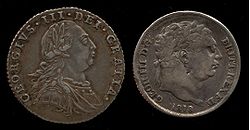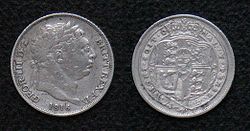
British sixpence coin
Encyclopedia

United Kingdom
The United Kingdom of Great Britain and Northern IrelandIn the United Kingdom and Dependencies, other languages have been officially recognised as legitimate autochthonous languages under the European Charter for Regional or Minority Languages...
pre-decimal coin, worth six (pre-1971) pence
Penny
A penny is a coin or a type of currency used in several English-speaking countries. It is often the smallest denomination within a currency system.-Etymology:...
, or 1/40th of a pound sterling
Pound sterling
The pound sterling , commonly called the pound, is the official currency of the United Kingdom, its Crown Dependencies and the British Overseas Territories of South Georgia and the South Sandwich Islands, British Antarctic Territory and Tristan da Cunha. It is subdivided into 100 pence...
.
In England
England
England is a country that is part of the United Kingdom. It shares land borders with Scotland to the north and Wales to the west; the Irish Sea is to the north west, the Celtic Sea to the south west, with the North Sea to the east and the English Channel to the south separating it from continental...
, the first sixpences were struck in the reign of Edward VI in 1551 and continued until they were rendered obsolete by decimalisation
Decimal Day
Decimal Day was the day the United Kingdom and Ireland decimalised their currencies.-Old system:Under the old currency of pounds, shillings and pence, the pound was made up of 240 pence , with 12 pence in a shilling and 20 shillings in a...
in 1971. Along with the shilling (12 pence) and the florin (2 shillings), the last general issue sixpence was issued in 1967 and a special proof
Proof coinage
Proof coinage means special early samples of a coin issue, historically made for checking the dies and for archival purposes, but nowadays often struck in greater numbers specially for coin collectors . Many countries now issue them....
version struck for inclusion in the farewell proof set of 1970. However, sixpences, shillings and florins continued to be legal tender at values of 2½, 5 and 10 new pence respectively.
Sixpences were originally supposed to be demonetized upon decimalisation in 1971. However, they remained legal tender until 30 June 1980.


Great Recoinage of 1816
The Great Recoinage of 1816 was an attempt by the British Government to re-stabilise the currency of Great Britain following economic difficulties precipitated by the French Revolutionary Wars and the Napoleonic Wars.-History:...
, the mint coined each troy pound (weighing 5760 grains) of standard (0.925 fine) silver into 66 shillings, or its equivalent in other denominations. This effectively set the weight of the sixpence at 43.636 grains or 2.828 grams from 1816 until the last striking in 1970.
The silver content followed the pattern of other silver coins. They were sterling silver
Sterling silver
Sterling silver is an alloy of silver containing 92.5% by mass of silver and 7.5% by mass of other metals, usually copper. The sterling silver standard has a minimum millesimal fineness of 925....
until 1920, when they were reduced to 50 percent silver. The last 50-percent-silver sixpence was minted in 1946; they were changed to cupro-nickel from 1947 onwards.
As the supply of silver threepence coins slowly disappeared, sixpences replaced them as the coins put into Christmas pudding
Christmas pudding
Christmas pudding is a pudding traditionally served on Christmas Day . It has its origins in medieval England, and is sometimes known as plum pudding or plum duff, though this can also refer to other kinds of boiled pudding involving dried fruit.-Basics:Many households have their own recipe for...
s; children would hope to be the lucky one to find the sixpence, no doubt also encouraging them to eat more pudding.
They have also been seen as a lucky charm for brides. There is an old rhyme which goes "Something old, something new / Something borrowed, something blue / And a sixpence for her (left) shoe."
They are also used as a good luck charm by Royal Air Force Aircrew who have them sewn behind their wings or brevets, a custom dating back to the Second World War.
In A Midsummer Night's Dream
A Midsummer Night's Dream
A Midsummer Night's Dream is a play that was written by William Shakespeare. It is believed to have been written between 1590 and 1596. It portrays the events surrounding the marriage of the Duke of Athens, Theseus, and the Queen of the Amazons, Hippolyta...
(Act 4, Scene 2), we learn that by his absence (ensorcelled in Titania's bower), Bottom the Weaver will forgo sixpence a day for life from the Duke. In Elizabethan times, the sixpence was roughly a day's wage for rustic labour in the provinces. With it, one might buy two dinner
Dinner
Dinner is usually the name of the main meal of the day. Depending upon culture, dinner may be the second, third or fourth meal of the day. Originally, though, it referred to the first meal of the day, eaten around noon, and is still occasionally used for a noontime meal, if it is a large or main...
s, six performances of Hamlet
Hamlet
The Tragical History of Hamlet, Prince of Denmark, or more simply Hamlet, is a tragedy by William Shakespeare, believed to have been written between 1599 and 1601...
among the groundlings at the Globe Theatre
Globe Theatre
The Globe Theatre was a theatre in London associated with William Shakespeare. It was built in 1599 by Shakespeare's playing company, the Lord Chamberlain's Men, and was destroyed by fire on 29 June 1613...
, or an unbound copy of the play
Play (theatre)
A play is a form of literature written by a playwright, usually consisting of scripted dialogue between characters, intended for theatrical performance rather than just reading. There are rare dramatists, notably George Bernard Shaw, who have had little preference whether their plays were performed...
itself.
"I've Got Sixpence" a popular song (possibly based on a traditional or vaudeville version) was published in 1941
1941 in music
-Events:*January 5 – Ernesto Bonino makes his début on Italian radio.*January 15 – Olivier Messiaen's Quatuor pour la fin du temps is premiered in Stalag VIIIA in Silesia.*January 20 – Béla Bartók's String Quartet No...
, words and music by Elton Box & Desmond Cox.
- I've got sixpence. Jolly, jolly sixpence.
- I've got sixpence to last me all my life.
- I've got twopence to spend and twopence to lend
- And twopence to send home to my wife - poor wife.
The singer tells the tale of spending twopence (per verse) until he has "no-pence to send home to my wife - poor wife."
Brian May
Brian May
Brian Harold May, CBE is an English musician and astrophysicist most widely known as the guitarist and a songwriter of the rock band Queen...
, guitarist from the British band Queen
Queen (band)
Queen are a British rock band formed in London in 1971, originally consisting of Freddie Mercury , Brian May , John Deacon , and Roger Taylor...
, uses a sixpence instead of a normal plectrum
Plectrum
A plectrum is a small flat tool used to pluck or strum a stringed instrument. For hand-held instruments such as guitars and mandolins, the plectrum is often called a pick, and is a separate tool held in the player's hand...
to play his guitar
Red Special
The Red Special is an electric guitar owned by Queen guitarist Brian May and custom-built by May and his father. The Red Special is also sometimes named in reviews as the Fireplace or the Old Lady, both nicknames used by May when referring to the guitar. A guitar that would define May's signature...
.
External links
- British Coins - Free information about British coins. Includes an online forum.
Coins of Great Britain

